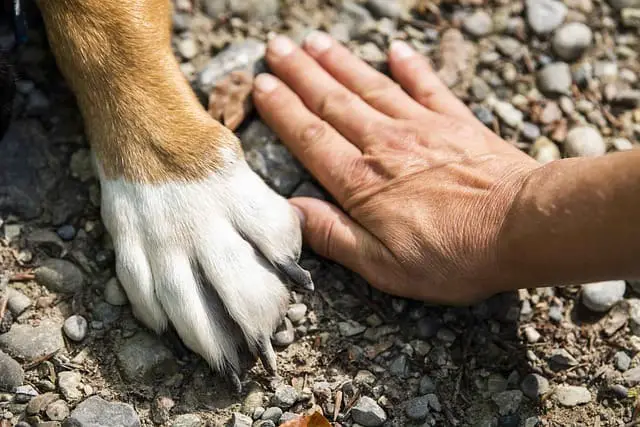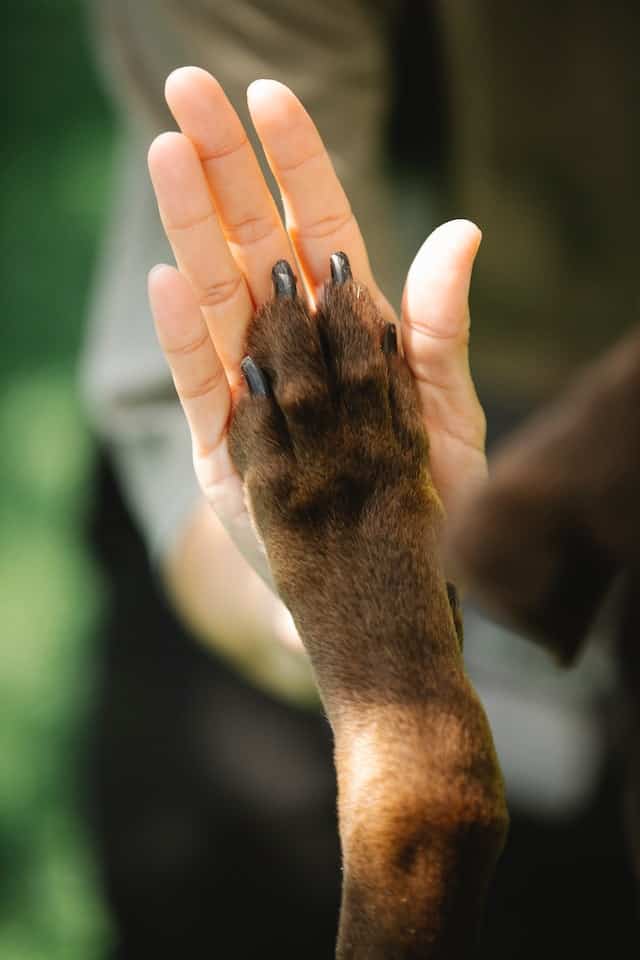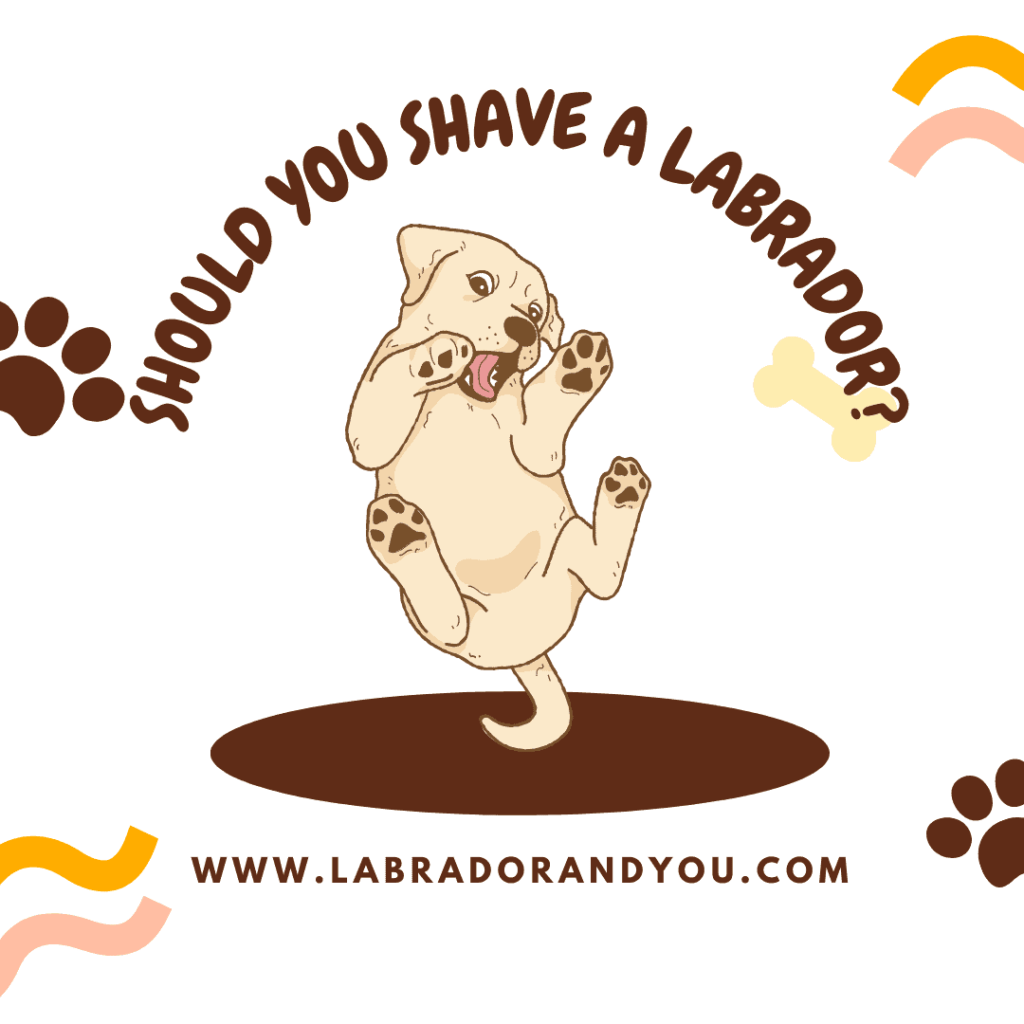Labs sport five toes per paw, with four regular toes and a dewclaw thrown into the mix. While the front five toes do all the heavy lifting, those hind dewclaws are positioned higher up on the paw.
What Do Labrador Paws Look Like?
The most popular breed in the world is the labrador retriever, usually called the Labrador. But have you ever stopped to look closely at labradors’ paws?
The paws of labradors are large and round, with a thick layer of padding on the bottom. This additional cushioning is a shock resistor and protects their bones and joints from injury. The toes are also well-padded and have thick nails well-suited for digging and playing.
Does The Labrador Retriever Type Have Webbed Toes?
Labradors are excellent swimmers, which makes sense considering their origins in Newfoundland, Canada. Fishermen originally bred Labrador Retrievers to water dogs. Have you ever noticed their toes? Yes! Their toes are slightly webbed, helping them paddle and swim more efficiently. This unique feature is why Labradors are such skilled swimmers.

How To Maintain Healthy Paws For Labrador Retriever?
As a Labrador Retriever owner, you must know labs are known for their high energy. They love to run, jump, swim and play, but this can take a toll on their paws. Your dog’s paws are their primary mode of transportation and help them navigate various terrains. Neglecting paw care can lead to painful conditions like cracked pads, infections, and more. Proper paw care techniques can prevent these conditions and keep your Labrador Retriever paws in shape.
Assess Your Labrador’s Paws Regularly
Check your Labrador’s paws regularly. Look for signs of injury, redness, swelling, or unusual growth. Consult a veterinarian as soon as you become aware of anything unusual. Your veterinarian can diagnose and provide treatment to keep your Labrador’s paws healthy.
Trim the Nails Regularly
Long nails can be uncomfortable for your Labrador and, if left untrimmed, cause significant problems, such as infections or pain while walking. Regular nail trimming is an essential aspect of paw care, and it’s best to do it once every 4-6 weeks. If you hear clicking on the floor, it’s a sign that they’re too long and it’s time for a trim.
Keep the Pads Clean and Moisturized
Dirt and debris can get trapped between your Labrador’s pads, causing discomfort and irritation. Regularly cleaning and moisturizing their pads can help prevent skin problems and keep labrador retriever paws healthy. Use a gentle cleaner, such as a mild soap, and dry their feet thoroughly. To keep the pads hydrated, use petroleum jelly or paw balm.
Protect the Paws from Hot and Cold Surfaces
Labrador Retrievers love to explore. However, their paw pads can be sensitive to hot and cold surfaces. Hot pavement can cause burns, and cold surfaces can cause discomfort and crack. To protect their paws, ensure they avoid walking on the hot pavement during summer. Invest in dog boots or paw wax to protect their paws during winter walks.
Take Care During Winter Months
Winter can be tough on your black lab paws, with the cold and salt used to melt snow causing cracking. To protect their paws, invest in dog boots. Wipe them with a damp cloth to remove salt and snow after each walk. Consider using a paw balm to keep the paws moisturized.

Tips for Successful Paw Care
Successful paw care for your Labrador Retriever requires regular attention, proper care, and patience. Here are a few tips to help ensure that your dog’s paws remain healthy and happy:
- Start young: If you’re a new pet parent, start caring for your Labrador’s paws from a young age. It will help them get used to the process to prevent issues later.
- Be consistent: Regular paw care is the key to success. Inspect and care for your dog’s paws daily, and make it a part of your routine.
- Be gentle: Your dog’s paws are sensitive. Handle them gently. Stop the process immediately and consult your veterinarian if you notice any pain or discomfort.
Vertical Force Distribution In The Paws During Walking
The labrador paw structure is unique. It helps the breed achieve a level of agility that is impossible for other breeds. So how does the paw structure enable them to distribute such a huge amount of vertical force?
Their paws are wider at the base and taper towards the tips, which helps distribute the weight evenly. The pads are thick and cushioned to absorb the impact of the weight and reduce the pressure on the bones and joints.
Researchers found that the labrador paw has a specific distribution of pressure points that helps distribute the force evenly across the paw. It allows the Labrador to move quickly and helps prevent injuries. The paw’s flexibility and strength allow the dogs to maintain their traction and grip regardless of the terrain.
FAQ
How Many Paws Does A Labrador Have?
A Labrador has four paws, which help them play, run, and show affection to its owners.
Do Labradors Have Big Paws?
Yes, Labradors are known for their big paws, adding to their adorable appearance. These big paws also help them swim and retrieve objects with ease.
Why Do Labradors Have Dew Claws?
Labradors possess dew claws for increased agility and balance while hunting, climbing, and swimming. These thumbs provide extra traction and grip, enhancing their physical abilities.
Why Remove Dew Claws On Labs?
Removing dew claws on Labrador Retrievers helps prevent future injury, ensures better movement, and enhances overall health.
How Should My Dog’s Paws Look?
Ensure your furry friend’s paws remain healthy by regularly checking for cuts, cracks, and dryness. Keep them protected with proper paw care.
Can I Put Coconut Oil On My Dog’s Paws?
You can safely apply coconut oil to your dog’s paws to moisturize and protect its skin.
Author Profile

- Product Reviews Specialist and Cofounder
-
Labradors have an extraordinary capacity for love and companionship, and my mission is to help you unlock their full potential. Hi there! I'm Sarah, a proud contributor to Labradorandyou, the go-to online resource for all Labrador Retriever enthusiasts. As a lifelong owner and avid admirer of these remarkable dogs, I bring a wealth of knowledge and hands-on experience to our readers.
One of my strongest beliefs is in the power of positive reinforcement training. I'm truly passionate about helping our readers build strong, positive relationships with their Labradors. Whether you're a first-time owner or a seasoned Labrador enthusiast, I aim to provide you with the resources and guidance to cultivate a bond that will endure a lifetime.
Also by the author
-
 Lab-TypesJune 30, 2025Çevrimiçi Oturum Açmaya Erişin Ve Bir Hesap Açın
Lab-TypesJune 30, 2025Çevrimiçi Oturum Açmaya Erişin Ve Bir Hesap Açın
-
 1xbet indiaJune 30, 20251xbet App 1xbet Cellular ᐉ Download Typically The 1xbet Apk Android Os & Iphone ᐉ 1-x-bet Com
1xbet indiaJune 30, 20251xbet App 1xbet Cellular ᐉ Download Typically The 1xbet Apk Android Os & Iphone ᐉ 1-x-bet Com
-
 casinoJune 30, 20251xbet Bahis’te En İyi Oranları Nasıl Belirlersiniz?
casinoJune 30, 20251xbet Bahis’te En İyi Oranları Nasıl Belirlersiniz?
-
 MonobrandJune 30, 2025Τι Είναι Το Rtp Και Τα Top 10 Φρουτάκια Με Υψηλό Rtp
MonobrandJune 30, 2025Τι Είναι Το Rtp Και Τα Top 10 Φρουτάκια Με Υψηλό Rtp





